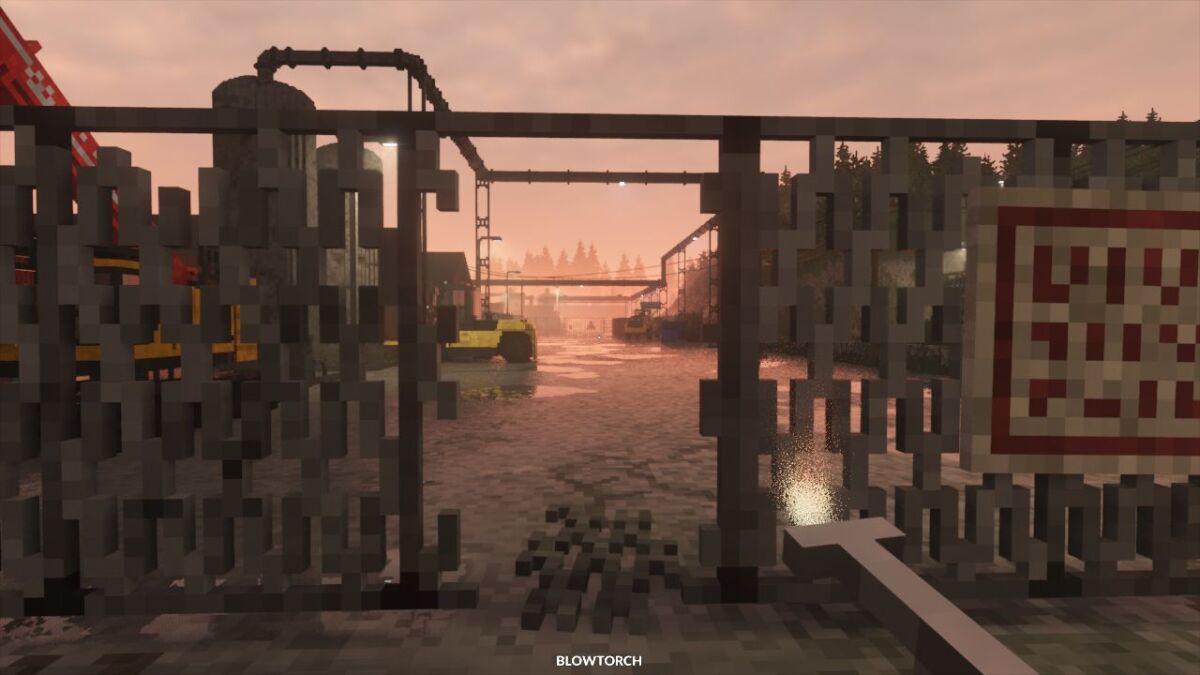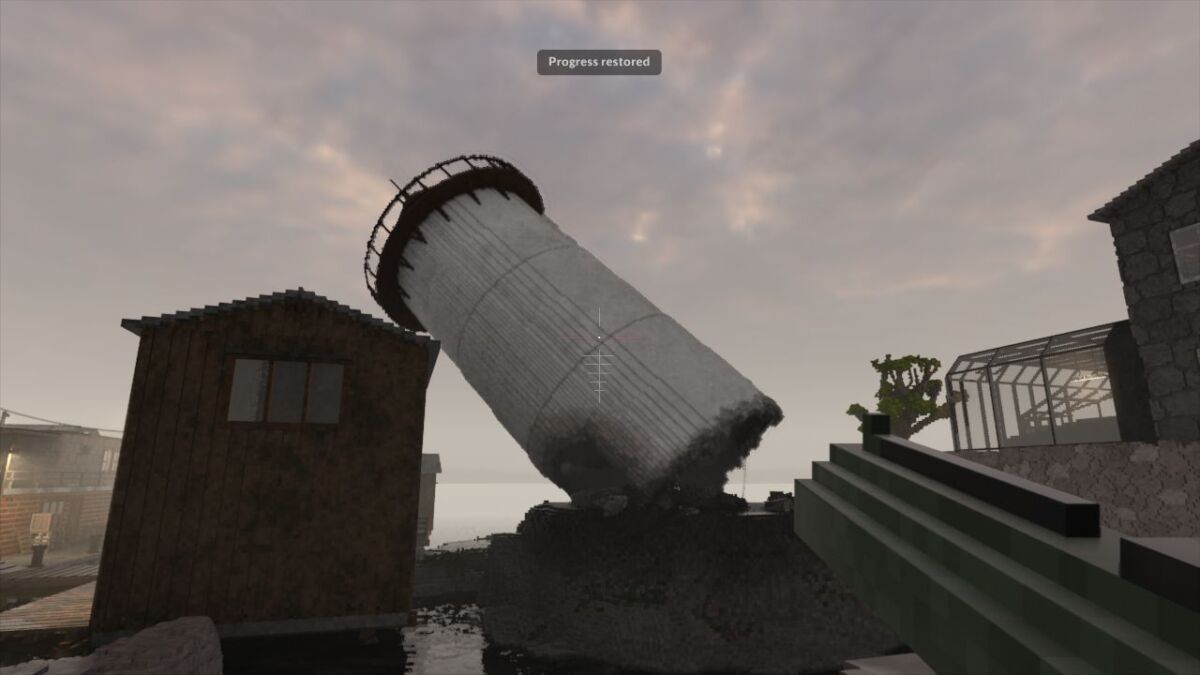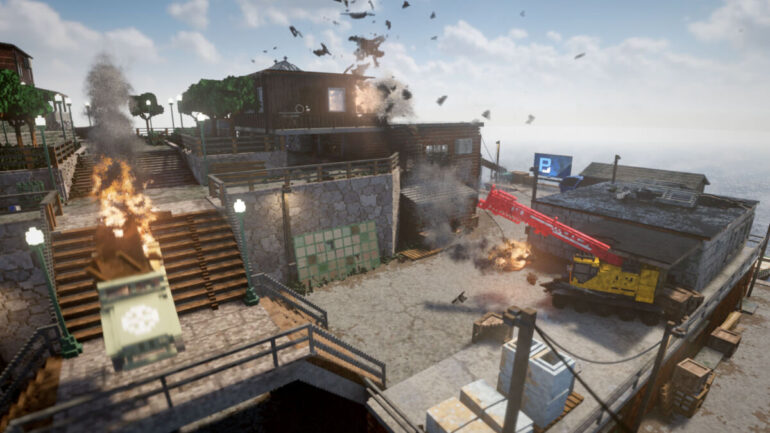Without wishing to display bias, simply hearing the concept of Teardown had me frothing at the mouth, and then they only went and pulled it off. An entirely destructible game world is something I’ve wanted for a long time, and I’m not alone in this sentiment. David Wong once cited the idea as a game feature everyone wanted but was simply impossible to achieve, claiming:
“As the hardware gets more powerful they always think of other things they’d rather do with it. And of course we’re not really asking them to program any possible piece of scenery to destruct, but all of it, at the same time. Because that’s what we’re going to do; forget about the fucking zombies and just destroy the entire goddamned town with grenades.”
And ok, you can’t destroy everything, you can’t tear apart the ground itself, you can’t bore down into the earth’s crust and out of the game world – but in spirit, and most of the time in practice, Teardown has given us what we wanted. It’s still in early access, but as a proof of concept, it’s an excellent one.

Unlike its voxel forebear Minecraft, which even with a final boss is ultimately open-ended, Teardown presents curated levels with strictly delineated objectives – and yet, because you can destroy pretty well anything you like, it still feels remarkably sandboxy and open. It’s mostly about getting the arena just so, with all the time and free modification you like, until you pull the trigger and the time limit kicks in.
Is it a tight time limit? Absolutely, and at first you’ll probably declare that on no planet could you do all that in sixty seconds. This is the beauty of Teardown, that it demands experimentation. If I do this, can I get from here to here quicker? Could that work? All of a sudden, you find you can cram an awful lot into one minute.
In the interests of full disclosure, I was so taken with the very concept of Teardown that I got it even though my rattly old computer doesn’t quite meet the minimum specs. It still runs, but slower than it should – which can be annoying, but when those time limits come into play, it’s sort of advantageous, like being in slow motion. There’s my game tip of the day, use hardware that isn’t quite up to the task in order to unlock permanent Matrix-style bullet time.
Currently, Teardown is if anything a puzzle game. But it occurs to me that given the arsenal you’re provided with in Teardown already includes two guns and a bazooka, and there’s a couple of levels where you’re attacked by a helicopter gunship, the ingredients for it to become a first-person shooter are all already there.
Honestly, this is not the direction I’d like to see it go. What appeals to me about Teardown is the creativity – both that demanded of the player, and of the game itself. By contrast, the core of the FPS hasn’t really changed since Goldeneye, with advancements being either minor, technical stuff, or gameplay modes (on which more later).
However, there is a seemingly limitless appetite for the genre, and the modding community have already whipped up a Teardown version of Counterstrike’s de_dust2 map, so it’s not impossible it may end up going that route, whether officially or unofficially. Although, I tremble to imagine the kind of ping you’d need for a multiplayer to function at all well when the debris starts flying everywhere.
‘Voxel-world with guns’ has already been attempted – by more than a few Minecraft mods, straight off the bat, but also by the shamelessly Minecraft-inspired Ace Of Spades. And it’s this last I particularly want to compare here, since Ace Of Spades made the advance of having blocks which weren’t connected to the ground tumble and fall, rather than stay floating in the aether. Fallen structures would then vanish into nothingness, but still, it had all the fun of knocking things down.
The original trailer for Ace Of Spades rather splashily showed off the ability to destroy vast constructions by taking out the foundations with a rocket launcher. This was about as true as advertising ever gets, since for most of Ace Of Spades’ existence it didn’t even have a rocket launcher in it. (In fact, it only did in the form of its less-popular Jagex reworking.) Teardown, in short, has made good on an unfulfilled fantasy I’ve had for quite some time.
Let this not come off entirely as a goo-goo-eyed puff piece. I’m being shamelessly subjective here, because sandboxes are what I like – and as such I really have to ding any choice which makes it less sandboxy. Here, in particular, I mean the car theft mission. Originally, the burglar alarms were linked to the cars’ spoilers, and through a bit of careful blowtorch work you were able to snip these off and drive the rest of the car away, only for Tuxedo Labs to patch this out. I can see why they did: it was a bit of a cheat, it goes against the spirit of rigorously planning your route to beat the clock, but still it feels a bit like losing a limb, that a whole great avenue of opportunity is permanently closed off.
A more salient gameplay flaw is the fact that when you blow a hole through a wall, satisfying as that always is, it results in debris piling up quickly. This is both an impressive display of the underlying technology, and a real pain if you need to drive a sports car through it. More than once I’ve found myself daintily tidying away the mess I’ve created, which feels uncomfortably like playing Yard Work Simulator when the game’s meant to be about gleeful, wanton destruction. Dare I say some kind of leafblower tool, to quickly hoover away all those little shards of brickwork, would be a very welcome addition.

Both Minecraft and Ace Of Spades allowed the player to, as well as destroying the voxel landscape, build more of it – pick up a cube here, plop it down over there. Teardown does have a build function, but it’s not the same modular alteration of the game world as its predecessors, rather using analogue planks to bridge gaps or staple things together. Nonetheless, any kind of construction element opens the door to borrowing two of Ace Of Spades’ more notable achievements: the Babel and Push game modes.
These concepts saw two teams attempting to build their way to the prize – either up to a layer of cloud in the sky, or along a series of islands to an end point, all of course while under constant fire from the other side. (Both were absent from the Jagex remake.) These were probably the game’s strongest points, actually incorporating the destructible voxel world into the gameplay, rather than simply layering a standard team deathmatch or capture-the-flag setup on top of it.
Here we strike on another important difference – that Teardown is made up of much smaller cubes. This gives a more detailed, more textured game world, but also means that placing them one at a time would require the services of tweezers and magnifying-glass. Ace Of Spades, however, did have a similar click-and-drag function to Teardown’s planks, allowing the player to place great angular lines of cubes, and later the Jagex version would let you put down more complex, prefabricated structures.
(Jagex’s advance, admittedly, would have killed the fun of Push. Originally you would have to slowly and tentatively peek out from behind your wall to keep building your bridge, one space at a time, all while under fire, rather than simply slapping down one you made earlier.)

In a way, Teardown’s modding community have already had their fun with this – one particularly streamer-baity mod replaces the humble pipe bomb with the ability to hurl small moons. This is meant to be used in more of a wrecking-ball way, but you can probably see how it’s transferable to being an ad hoc building function. Come up against a canyon too wide to put a plank over? No worries, fill the bugger with celestial bodies so you can skip right across.
This isn’t limited to the playground of mods – the moons are simply a particularly striking illustration. Teardown has also split from its cubic brethren in including Havok-style click-and-drag physics objects. Playing through the base game, you will likely improvise yourself a Babel-style ramp or ladder upward, and there’s endless options for how to do so. Drive a crane into the right spot, knock down a tree, cut off a bit of fencing and rearrange it. All perfectly possible, and when they work, marvellously satisfying.
To invoke Babel and Push, though, isn’t necessarily to say ‘oh, this is the direction Teardown should move in’. If anything, it’s already gone in that direction, given that it features a lot of bridging of point A and point B. Rather, Babel and Push are emblematic reminders of the kind of free-form creativity the world of Teardown allows – well, any voxel world, but we’re talking about Teardown here. It has created a game world where, if not any game, then a huge number of game modes could be played out.
(And case exemplar of Teardown’s playful attitude – one level, a sleek modern mansion, has a miniature racetrack right in its back yard.)
READ NEXT: Best Indie Games of All Time
Some of the coverage you find on Cultured Vultures contains affiliate links, which provide us with small commissions based on purchases made from visiting our site. We cover gaming news, movie reviews, wrestling and much more.



